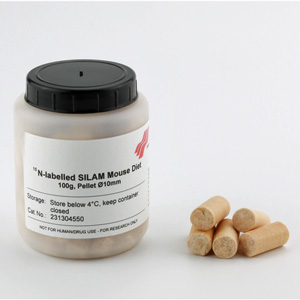A Proteomics and Metabolomics Study using 15N-SILAM mouse diet
In the article “Ketamine’s Effects on the Glutamatergic and GABAergic Systems: A Proteomics and Metabolomics Study in Mice”, published in 2019 in the journal “Molecular Neuropsychiatry”, Prof Christoph W. Turck of the “Proteomics and Biomarkers” research group at the Max Planck Institute of Psychiatry used 15N-Silam mouse diet to isotopically label mice in vivo. Tissue and blood proteins from these mice served as reference material for proteomics studies.
In the following, Prof. Turck provides insights into the research.
What research results were achieved by stable isotope labeling with SILAM mouse diet?
The acquired mass spectrometry data allowed us to delineate molecular pathways involved in the Ketamine drug response. Specifically, we found that AMPAR subunit Gria2 expression is affected. This results in a decrease of GABAergic inhibitory neurotransmission and an increase excitatory neuronal activity.
What makes the study of Proteomics and Metabolomics so relevant?
The high variability in response, combined with a lack of clinically useful assessments that can reliably predict whether a patient will respond to a particular antidepressant compound, prevent a strategic treatment and personalized medicine approach in psychiatry. Both biomarkers predicting a priori whether an individual patient will respond to the treatment of choice, as well as an early distinction of responders and non-responders during antidepressant therapy would improve the situation significantly.
To delineate affected molecular pathway details we analyzed brain tissue sections and plasma of Ketamine-treated mice by proteomics and metabolomics. For this purpose, we carried out a time-dependent quantitative mass spectrometry study using in vivo 15N metabolically-labeled mouse proteins as reference for comparing ketamine- and vehicle-treated mice.
How was the SILAM mouse feed applied?
Proteins from Ketamine-treated mice were mixed with equal amounts of 15N-labeled protein from the same tissue to serve as internal reference standard. 14N/15N protein mixtures were separated by SDS polyacrylamide gel electrophoresis, and gel slices subjected to tryptic in-gel digestion. The resulting peptide mixtures were then analyzed by tandem mass spectrometry for protein identification and relative quantification.
What was the background of the research with 15N Mouse?
Our research centers on the identification of biosignatures for psychiatric disorders and the response towards antidepressant drugs. Sensitive, high-throughput proteomics and metabolomics platforms are used for data generation providing a rich source for in silico pathway analyses.
Our ultimate goal is to complement imprecise DSM-based clinical parameters with molecular biosignatures to improve patient diagnosis, stratification and treatment. Towards this objective we collaborate with clinician scientists exploring and mining a variety of specimen sources for biomarkers.
What is the connection between the mouse diets and mass spectrometry?
Quantitative mass spectrometry is a versatile tool for the accurate quantification of proteins and metabolites. For this purpose, stable isotope-labeled reference molecules (2H, 13C, 15N) can be used as internal standards. For metabolic labeling of mice, a special diet was developed.

Why choose Silantes as a supplier of SILAM mouse feed?
“The collaboration with Silantes scientists for the development of an optimized mouse feed was critical for the success of this and several other proteomics projects.”
Prof. Chris Turck
Silantes has always been forthcoming in helping us with our projects that involved stable isotopes. Following the successful development and application of the SILAM feed for quantitative proteomics, we have more recently expanded its use for protein turnover analysis in mice by subjecting the animals to a partial labeling procedure.
Article: https://www.karger.com/Article/FullText/493425
Source: Weckmann K, Deery M, J, Howard J, A, Feret R, Asara J, M, Dethloff F, Filiou M, D, Labermaier C, Maccarrone G, Lilley K, S, Mueller M, Turck C, W: Ketamine’s Effects on the Glutamatergic and GABAergic Systems: A Proteomics and Metabolomics Study in Mice. Mol Neuropsychiatry 2019;5:42-51. doi: 10.1159/000493425
Visit our shop to find the product used in the study: Silantes 15N-labeled SILAM Mouse Diet
Learn more about our full range of products for NMR and mass spectrometry.


